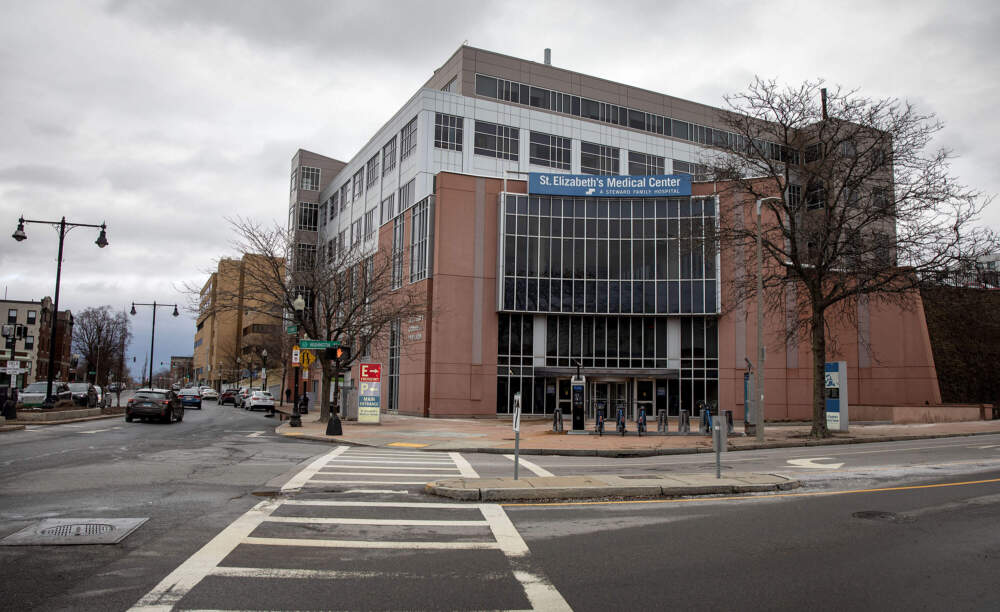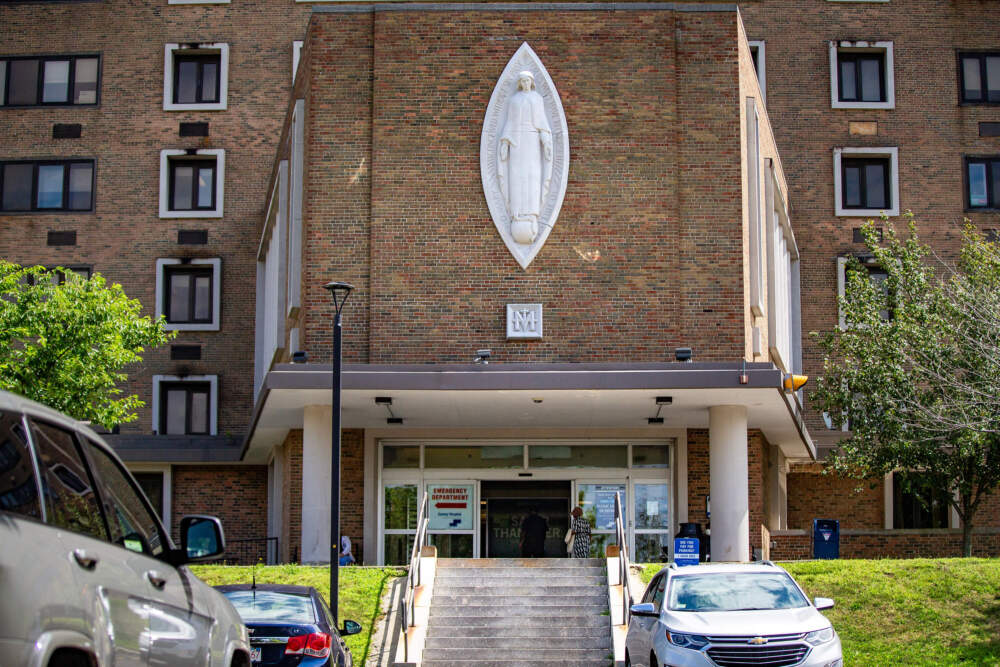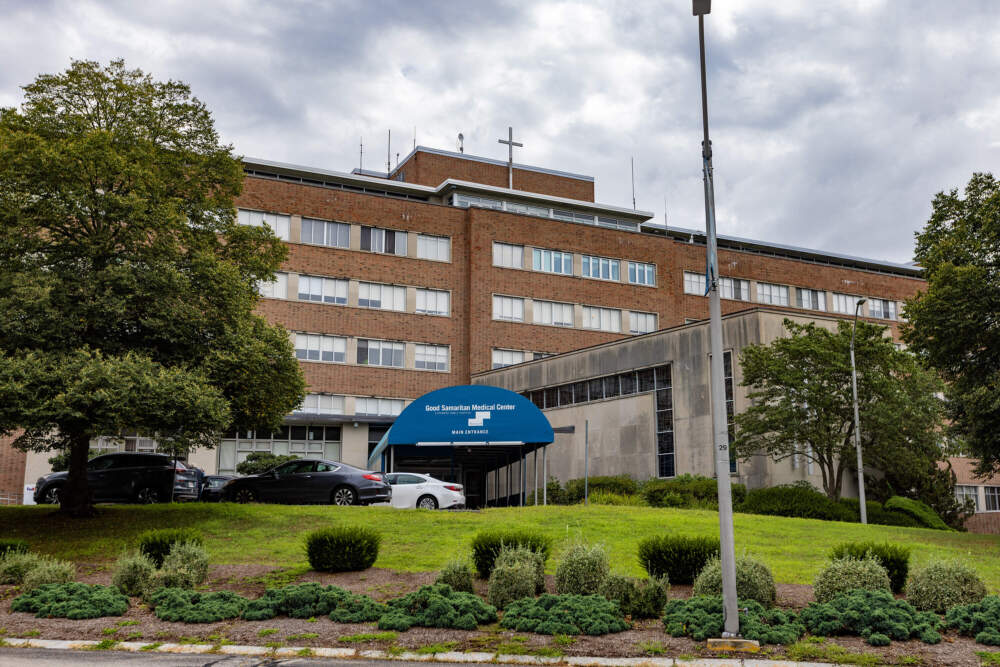Advertisement
Healey: State to take control of St. Elizabeth's, tentative deals reached for other Steward hospitals
Resume
After months of uncertainty about the future of Steward Health Care, Gov. Maura Healey unveiled a plan Friday to save five Massachusetts hospitals operated by the bankrupt hospital chain.
Healey said her administration would take control of St. Elizabeth’s Medical Center through eminent domain to facilitate the transition to a new owner. Tentative deals have been reached, she said, to sell the remaining Steward facilities.
If the deals are finalized, Lawrence General Hospital will take over both campuses of Holy Family Hospital in Haverhill and Methuen, while the Rhode Island-based Lifespan system will operate Morton Hospital in Taunton and St. Anne’s Hospital in Fall River.
Boston Medical Center will take control of Good Samaritan Medical Center in Brockton, and eventually, St. Elizabeth’s, after final deals are signed and approved.

The ownership changes would bring the five hospitals under the control of locally-based nonprofit health care providers — instead of the for-profit Steward system, which was launched with private equity backing and is based in Dallas.
Healey described the changes as the start of a new and improved chapter for patient care in Massachusetts.
"I'm pleased to say we're closing the book on Steward, once and for all, in Massachusetts. It's good riddance, and goodbye," Healey told reporters gathered at the State House.
In a hearing before a bankruptcy court judge earlier Friday, an attorney for Steward said some issues remained unresolved, but the company was hopeful deals for all, or all but one, of its remaining Massachusetts hospitals could be finalized in the coming days. The attorney, Ray Schrock, did not mention the agreements in principle or the possibility of a state takeover of a Steward facility by eminent domain.
Spokespeople for Steward declined to comment on Healey's announcement.
Steward has been negotiating behind closed doors with potential buyers for weeks. The deals have been complicated largely because the real estate is owned separately from the hospital operations, and potential buyers did not want to take on the rent payments Steward had been paying.
Steward’s Massachusetts hospitals were jointly owned by Medical Properties Trust (MPT) and Macquarie Asset Management. Those companies recently agreed to hand the properties to their mortgage holder, Apollo Global Management, to facilitate sales.
Advertisement

But Healey said Friday the property owner was holding up the deal.
“Unfortunately, after endless go-rounds, back-and-forth in negotiations, the landlord has refused to move,” she said. “So as governor, I am taking action today to seize control of St. Elizabeth's through an eminent domain proceeding that will facilitate the transition of St. Elizabeth's to a responsible new owner.”
Healey said the state would offer Apollo $4.5 million for St. Elizabeth's Medical Center, which she characterized as "fair market value," followed by an order to take the property.
Apollo officials declined to comment.
Leaders from labor unions representing workers at Steward’s hospitals, the Massachusetts Nurses Association and 1199SEIU, praised Healey for her efforts to save the hospitals.
“This is the exact kind of aggressive action that the healthcare workers of 1199SEIU have been demanding from our state leaders," Tim Foley, executive vice president of 1199SEIU, said in a written statement.
Steve Walsh, president of the Massachusetts Health & Hospital Association, said he was encouraged to see “trusted health systems are on track to take over Steward’s Massachusetts hospitals” and return them to “normalcy.”
But two other Steward facilities, Carney Hospital in Dorchester and Nashoba Valley Medical Center in Ayer, are slated to close by the end of this month, after Steward said they didn’t receive any viable offers. The planned closures have drawn protests from health care workers and community members who worry patients will suffer from longer wait times and worse health outcomes.
Despite the outcry, Healey has declined to take steps to stop the Carney and Nashoba Valley closures. She placed the blame Friday squarely on Steward's shoulders. Healey said the hospitals were in such poor condition, no other operator wanted to run them.
"There was no hospital operator willing to come forward," Healey said. "That's why those hospitals are set to close. It's because of Steward, and because of what Steward did in running them to the ground."

Foley said he hopes the state will work to preserve care at these sites, and continue pressing for laid off workers to receive severance pay and compensation for accumulated time off.
"We need the same level of uncompromising commitment to patients and workers at Carney and Nashoba Valley that we’ve seen from the state when it comes to the other Steward hospitals," Foley said.
Steward has postponed the court hearing for its Massachusetts hospital sales until Aug. 22. It was not immediately clear how much money the hospital sales would generate.
Steward filed for Chapter 11 bankruptcy protection in May, after failing to pay vendors and accumulating billions of dollars in debt. It put its hospitals and doctors group up for sale. Earlier this week, Steward announced a deal to sell the physicians network to private-equity backed Rural Healthcare Group for $245 million.
The potential new operators for the hospitals have not been publicly known until now.
On Friday, BMC officials said in a statement that they’re working to take over Good Samaritan and St. Elizabeth’s “to help mitigate a looming public health crisis in the region.”

If the deal is approved, the officials pledged to work with staff at both hospitals “to revitalize clinical services and help the communities they serve thrive.”
Lifespan officials said they’re continuing to finalize the terms of their bid and noted the deals also need approval from state and federal regulators.
Dr. Abha Agrawal, chief executive of Lawrence General Hospital, said she looks forward to building “a regional health care system in the Merrimack Valley.”
“We are excited about the opportunity that puts quality and safety at the forefront of everything we do,” she said in a statement.
Healey administration officials have been deeply involved in the hospital sale process and are developing a plan to help the new owners of the Steward hospitals. This includes $80 million a year, for three years, in state and federal funding toward operations and investments in the facilities. The administration also plans to advance Medicaid payments to help the hospitals stay afloat after they transition to new owners.
“The work for them starts now,” Kate Walsh, secretary of health and human services, told reporters Friday. “They’re going to be taking over these hospitals, they’re going to be staffing them up, stocking them up, and making capital investments to make sure that they’re safe. And that will take funds that we’re working with them to make sure they have.”
In the nearer term, state officials have agreed to pay $30 million in advance Medicaid payments to help the Steward hospitals stay open through the end of the month.
Steward was founded in Massachusetts in 2010 with the promise of rescuing and strengthening struggling Catholic hospitals. But the company and its leaders — especially chief executive Ralph de la Torre — have come under fire from public officials this year for greed and mismanagement. Healey on Friday said de la Torre should be “investigated, prosecuted, held accountable” for the harm he’s done to Massachusetts.
"None of us wanted to be here in the first place," Healey said. "It was something that was created by the greed and the exploitation of an individual, Ralph de la Torre, and members of his team. De la Torre's actions brought us to nearly the brink of collapse here in Massachusetts at all seven of the Steward hospitals."
Steward’s leaders have blamed the company's financial problems on factors including inadequate reimbursement rates for patients on public insurance, increasing labor and supply costs and the lingering effects of the COVID-19 pandemic.
This article was originally published on August 16, 2024.
This segment aired on August 16, 2024.

